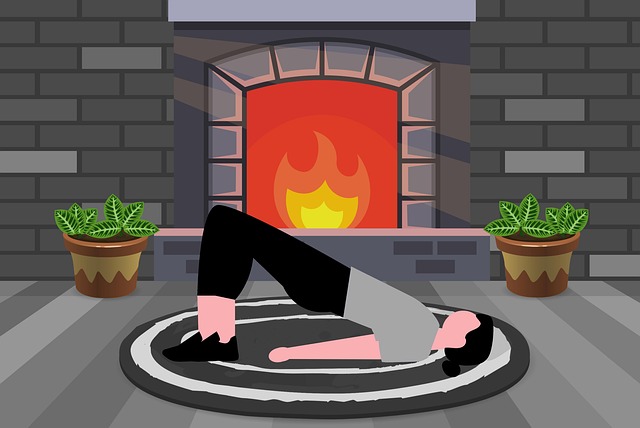Yoga therapy is a holistic approach to healing trauma, offering mindfulness, gentle movements, and breathwork in a safe space to process emotional patterns, reduce stress, and enhance self-awareness. Combining physical postures, meditation, and relaxation techniques, it aids in regulating the nervous system, releasing tension, and cultivating resilience, making it an effective tool in trauma-informed care for comprehensive emotional healing.
Trauma-informed therapy offers a transformative approach to healing, recognizing the profound impact of traumatic experiences on both the body and mind. This article explores comprehensive strategies for recovery through a unique lens—yoga therapy. We delve into the science behind trauma’s effects, its potential to regulate the nervous system, and provide practical guidelines for creating safe, supportive therapy spaces. Discover how integrating yoga into treatment plans can facilitate profound and lasting healing.
- Understanding Trauma and Its Impact on the Body and Mind
- The Role of Yoga Therapy in Promoting Healing and Regulation
- Practical Application: Creating a Safe and Supportive Therapy Space
- Integrating Yoga into Trauma-Informed Treatment Plans for Comprehensive Healing
Understanding Trauma and Its Impact on the Body and Mind

Trauma, an intense or deep emotional experience, can leave lasting effects on both the mind and body. When individuals face traumatic events, their brains release a surge of stress hormones, leading to significant changes in physiological functions. Over time, if these experiences are not processed and resolved, they can manifest as various mental health issues, such as anxiety, depression, or complex post-traumatic stress disorder (PTSD). Yoga therapy offers a unique approach to understanding and healing from trauma. Through mindfulness practices, gentle movements, and breathwork, this ancient practice helps individuals cultivate self-awareness, regulate their nervous system, and process deep-seated emotional patterns.
The mind-body connection is a powerful aspect of yoga therapy, allowing clients to explore and release held tensions, fears, or memories associated with traumatic events. By focusing on the present moment and cultivating a sense of safety, individuals can begin to heal from the profound impact that trauma has had on their overall well-being. Yoga provides a nurturing space for self-exploration and recovery, enabling people to develop coping strategies and enhance their resilience as they navigate the path towards comprehensive healing.
The Role of Yoga Therapy in Promoting Healing and Regulation

Yoga therapy plays a pivotal role in trauma-informed therapy, offering a holistic approach to promote comprehensive healing and emotional regulation. Through a combination of physical postures, breathwork, meditation, and mindfulness practices, yoga therapy helps individuals cultivate self-awareness and develop coping mechanisms to manage traumatic stress responses. The gentle yet powerful movements and focused breathing techniques encourage the release of tension and promote relaxation, allowing the mind and body to find balance.
In trauma healing, yoga therapy provides a safe and supportive space for clients to reconnect with their bodies, process emotions, and regain a sense of control. By incorporating yoga into the therapeutic framework, practitioners can address the physical, mental, and spiritual aspects of recovery. This nurturing approach facilitates a deeper understanding of one’s traumatic experiences and fosters resilience, ultimately supporting individuals on their journey towards holistic healing and well-being.
Practical Application: Creating a Safe and Supportive Therapy Space

In trauma-informed therapy, creating a safe and supportive space is paramount for comprehensive healing. This involves establishing an environment that fosters trust, encourages vulnerability, and respects the individual’s unique experience. Yoga therapy, as a complementary practice, plays a significant role in achieving this. Through gentle movements, mindful breathing exercises, and guided meditation, therapists can help clients develop self-awareness and learn to regulate their emotions effectively. The physical aspect of yoga helps to reduce stress and anxiety, creating a sense of safety within the therapeutic setting.
Additionally, yoga therapy offers a non-verbal means of communication, which can be particularly beneficial for individuals who struggle with verbalizing their experiences or emotions. By focusing on the present moment and prioritizing self-care, clients are empowered to reconnect with their bodies and minds in a nurturing way. This safe space not only facilitates healing but also enables clients to build resilience and develop coping mechanisms tailored to their specific needs, fostering a deeper sense of well-being.
Integrating Yoga into Trauma-Informed Treatment Plans for Comprehensive Healing

Integrating Yoga into Trauma-Informed Treatment Plans offers a holistic approach to comprehensive healing. Yoga therapy provides a safe and supportive space for individuals to connect with their bodies, minds, and emotions. Through gentle movement, breathwork, and mindfulness practices, clients can cultivate self-awareness, regulate stress response systems, and process traumatic memories in a controlled environment. This non-threatening method allows for profound emotional releases while fostering resilience and a sense of calm.
Yoga therapy complements trauma-informed treatment by addressing the mind-body connection, which is often disrupted by traumatic experiences. The physical aspects of yoga help to reduce muscle tension and promote relaxation, while mental focus and awareness during practice can aid in reframing negative thought patterns associated with trauma. Tailoring yoga practices to individual needs ensures a personalized journey towards healing, enabling clients to regain a sense of control and empowerment.
Trauma-informed therapy, enriched by practices like yoga, offers a transformative path towards healing. By understanding trauma’s profound impact on both mind and body, therapists can create safe spaces that support individuals in processing and regulating their experiences. Yoga therapy serves as a powerful tool within this framework, promoting physical and mental restoration through mindfulness, movement, and breathwork. Integrating these practices into treatment plans not only enhances the comprehensive healing process but also empowers individuals to cultivate resilience and find solace in their journey towards well-being.
